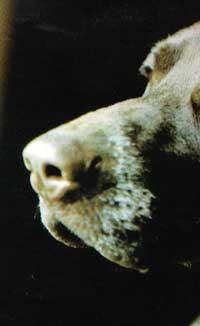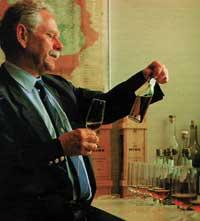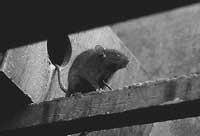Use it! Use it!
Remove your electronic nose with total discretion and use it in one or two on the forest. After a few seconds, if the light gets green, you can hit the train. However, if red light is lit, look for the right pot.

Portable and preprogrammed connoiseurs are not going to be so far away, but scientists are at the mercy of something bigger they believe they can mimic the ability of the human or animal nose through a range of optical fibers integrated into a chip. The artificial smell may seem strange, but the simple olfactory ones have already made a gap between us. The electronic noses were marketed about five years ago. The electrochemical sensors connected to a PC perform a quality control. They are prepared to identify odors that human noses would cast back. Thus, they control aromatic products such as beer wineries. Scientists believe that electronic noses can enter the field of wine tasters or, even more, in that of usnantes dogs.
According to some researchers, the arrival of the electronic noses, diminished of the size of a silicon chip from the current tabletop storage rooms, will lead to the revolution of artificial olferation. These integrated nasal brains (small, powerful and consuming only some energy from a stack) will become as ubiquitous as the microprocessor, forming phones, ovens, cars and hospital appliances. On this path, scientists believe they will solve some mysteries of natural usanza.

George Dodd, considered the father of the technology of electronic noses, continues to observe envy to the usnantes dogs. These “legs with nose” can smell the buried mines or hidden drugs in airplane luggage and hear the body smell of a fugitive in large odorous meadows. The smell of the dog is as fascinating as it is paradoxical according to Dodd.
Think that the smelling dog is a radio receiver that instead of taking electromagnetic waves takes odour molecules that flow through the air, they are of oil, perfumes, garlic oil or other odorous substances. Without a doubt, it can detect a wide spectrum of odors, even if it is a molecule in hand between a billion air molecules. Radio engineers would have a difficult task of matching. “The smell of a dog has a great bandwidth,” says Dodd. It can smell everything and also with incredible sensitivity and that is the most paradoxical.”
Inflated successes
In the early 1980s, Dodd and his colleagues at the University of Warwick took the first step when they managed to imitate one of the characteristics of the dog's nose on the path of artificial oblivion, imitating his sensitivity to a broad spectrum of odors. They obtained a set of chemical sensors, formed by three different conductive polymers. At microscopic level, the material has the form of a spaghetti-mataza, in which polymers are inflamed by absorbing odour molecules. This modifies the conductivity and produces a quantifiable change in the amount of electric current that passes through them.

Each of the three Dod plastics reacts differently to odour molecules. For example, in contrast to the essence of the orchard, the sensors first and second absorb more the smell than those of the third and present a decrease of the most pronounced conductivity. But placed in front of the rose oil, the behavior of the sensors will be completely different and it is possible that only one of the sensors absorbs many odors. This has a special electrical footprint for any smell you forget. This tool was the first step towards the electronic nose.
The noses currently on sale have the same base, but they have a greater number of sensors to achieve a wider sensitivity zone. The noses take advantage of the neuronal network to learn spectra of response to different odors. Before going to work, they train, for example, to detect chemical compounds that are responsible for the special smell of a lost beer. For example, in a part of the process of making the beer, there may appear a bad aroma in the form of butter that is formed in diacetylene. If the winery is left for a while on its surface, diacetylene is transformed into tasteless butandiol. The nose is placed alternately in front of the brooms with diacetylene and is told when it is okay and when it is not. After this training the nose will detect the diacetylene without a vacuum.

High, researchers work with new generation noses. Neuroscientist John Krauer and chemist David Walt, of the University of Tufts in the United States, believe that the base is in the imitation of nature, studying the noses of dogs, goats and rats. They will be used as models of artificial nasal cavities to check if the airflow received by the sensors affects sensitivity. Dogs have nasal cavities more complex than humans, which can result in air flows that can increase their olfactory power. The work of this group has gone through the model level.
Guisante size organ
The smell hardware in humans is located at the top of the nostrils, in a section of tissue called the epithelium nose. When the odors pass through there are about 10 million sensors, each with thousands of different chemical receptors. By smelling the odour particles act on a receptor that sends electrical signals to a couple of organs the size of a brain pea, the olorative bulbs. Subsequently, the signals are processed and identified.

To mimic the high sensitivity of the nasal epithelium, Tufts University uses optical fibers. The ends of these optical fibers are coated with different plastics with a dye called Red Nile. These ends absorb odour molecules and act as sensors. Through fibers, the light is transmitted to the ends, where the fluorescence of the dye is produced. Part of the luminous fluorescence is shifted back through the fiber and its intensity can be measured by an electronic eye. The process is similar to the one described above, plastics absorb odour molecules and become inflamed. Consequently, the intensity of the light that goes back through the fiber changes.
According to researchers at the University of Tufts, the fiber optic user will be more sensitive than current market users. They justify that with an optical instrument three parameters can be measured: the intensity of the light, the wavelength of the light and the duration of the fluorescence. In a series of recent sessions, the optical nose of Tufts University has been able to differentiate three alcohols that had only the part of a carbon atom in the structure.
On a chip
Natham Lewis, of the California Institute of Technology, wants to go further. Lewis aims to place around 10,000 plastic sensors and their neuronal management network on a chip. The presence of many sensors would allow to obtain many different responses by putting them in front of odour molecules, multiplying the separation capacity between different odors.

However, this approach is arguable. Other researchers consider that the degree of difference between sensors is the most important and not the number of sensors. According to them, the information that can be obtained with ten sensors or with one million is equivalent. Lewis disagrees: with ten sensors, he says, you can detect if there is smoke in your home. But he wants more.
Lewis uses plastics to produce sensors, but is not limited to conductive plastics only. Last year, a system of table odors of 17 sensors was prepared to distinguish between wine and spirits and fresh and rotten fish. However, he worked quite slowly. From there they go fast and have already managed to place five sensors in a chip, yes, without neuronal networks. Therefore, they have a nose without a brain. According to Lewis, his team will have approximately three years of time 10,000 sensors and a neuronal network integrated into a chip. He says they are not science fiction. And the basic technology is available.

What can you do after getting it by placing a nose on a chip? Everything you want. For example, you can put the bread on the toaster or in the oven to tell if it starts to burn.
The noses currently existing in the market require about two minutes to identify a smell, since the data obtained from the sensors must be stable. A nasal chip would be faster, among other things because the odour molecules would need less time to inflame the plastic. According to Lewis, “from a quick nose you can reach the source of the smell by changing the direction of the wind. You can think of putting your nose in a robot looking for a pump at an airport, which needs a quick response in real time.”
They are about to come, don't you listen already?
Buletina
Bidali zure helbide elektronikoa eta jaso asteroko buletina zure sarrera-ontzian











